
Like animals, plants also use camouflage to hide from predators
Camouflage is a tactic many associate with certain reptiles or birds, but a new study has shown that many plant species also use the same camouflage techniques that animals use for disguise.
Researchers from the University of Exeter and the Kunming Institute of Botany in China examined camouflage in plants in an effort to better understand the unique evolutionary processes at work.
The study was published in the journal Trends in Ecology and Evolution.
Plants use a variety of well-known camouflage tricks used in the animal kingdom, including background matching and masquerading itself to look like something else.
Some species of octopus and cuttlefish are experts in masquerade and can actually change the texture of their skin in order to look like other marine animals or objects.
A species of plant that uses masquerade camouflage is the Corydalis hemidicentra, with leaves that are the same color as the rocks around it, depending on where it grows.
“These plants are a wonderful example of how camouflage can be adapted for different habitats,” said Yang Niu of the University of Exeter, first author of the study. “It seems that plants like these know how to make the right colors by mixing a few types of pigments. Those individuals with worse color matching might have higher risk of being eaten.”
Other camouflage techniques that plants use are disruptive coloration, where markings are used to create the illusion of a false edge, and decoration, which involves a plant covering itself with materials from the environment like sand to hide obvious features.
“It is clear that plants do more than entice pollinators and photosynthesize with their colors – they hide in plain sight from enemies too,” said Martin Stevens, an author of the study. “We now need to discover just how important a role camouflage has in the ecology and evolution of plants.”
One limiting factor for plants who employ camouflage tactics may be that changing colors decreases photosynthesis because chlorophyll is green.
The researchers note that further studies of plant camouflage could reveal important evolutionary insights.
“Animal camouflage has provided scientists with arguably the best examples of evolution in action,” said Stevens. It has been widely studied since the first pioneers of evolutionary biology, but relatively little research has been done into plant camouflage. Plants give us a fascinating parallel way of understanding how evolution works.”
—
By Kay Vandette, Earth.com Staff Writer
Image Credit: Yang Niu












